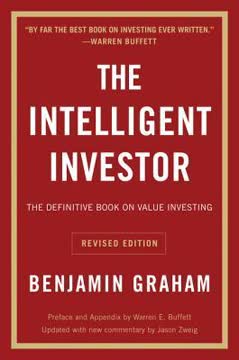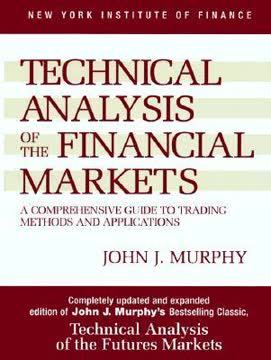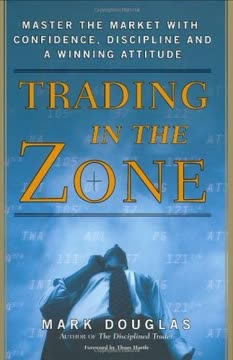Key Takeaways
1. Classical charting principles provide a framework for successful commodity trading
Charts are a trading tool, not a predictive tool. Charts can provide traders with a slight edge, but should not be used to make price forecasts.
Chart patterns as trading signals. Classical charting principles, developed by pioneers like Charles Dow and Richard Schabacker, offer a systematic approach to analyzing market behavior. Key patterns include head and shoulders, triangles, channels, and flags. These formations can indicate potential trend reversals or continuations.
Edge, not certainty. Chart patterns provide traders with a slight edge, not guaranteed outcomes. Successful traders use this edge consistently over time to generate profits, similar to how casinos rely on small statistical advantages. It's crucial to understand that charts are tools for identifying potential trades, not for predicting exact price movements.
Pattern recognition skills. Developing the ability to quickly identify valid chart patterns is essential. This skill comes through experience and studying historical examples. Traders should focus on patterns with clear, well-defined boundaries and avoid over-interpreting ambiguous formations.
2. Successful trading requires discipline, patience, and emotional control
Successful trading is an upstream swim or uphill run against human nature.
Emotional challenges. Trading consistently triggers powerful emotions like fear, greed, hope, and anxiety. These emotions can lead to impulsive decisions, overtrading, or hesitation at crucial moments. Successful traders develop strategies to recognize and manage these emotional responses.
Discipline in execution. Adhering to a pre-defined trading plan, even when it feels uncomfortable, is crucial. This includes:
- Entering trades only when specific criteria are met
- Sticking to predetermined stop-loss and profit-taking levels
- Avoiding the temptation to overtrade or chase missed opportunities
Patience in waiting for setups. The best trading opportunities often require extended periods of waiting. Resisting the urge to force trades during quiet periods is a key skill. Successful traders understand that preserving capital during suboptimal conditions is just as important as capitalizing on clear opportunities.
3. Risk management is more crucial than trade identification
Risk management must be given priority over trade identification to achieve consistently successful performance.
Position sizing. Proper risk management starts with determining appropriate position sizes. The Factor Trading Plan typically risks no more than 1% of capital on any single trade. This approach helps preserve capital during inevitable losing streaks.
Stop-loss placement. Utilizing concepts like the Last Day Rule (placing stops beyond the high/low of the breakout day) provides a systematic approach to limiting losses. Trailing stops and other techniques can be used to protect profits as trades develop.
Overall portfolio risk. Consider correlations between different positions to avoid overexposure to similar market factors. The Factor Trading Plan aims to limit risk in highly correlated markets (e.g., grains, currencies) to 2% of total assets.
4. Develop and stick to a comprehensive trading plan
A trading plan must address the issue of risk management, namely, what proportion of capital will be risked on any given trading event.
Key components of a trading plan:
- Trade identification criteria
- Entry and exit rules
- Position sizing and risk parameters
- Overall portfolio management guidelines
Consistency is key. The power of a trading plan comes from its consistent application over time. This allows traders to benefit from their edge across a large number of trades, smoothing out the impact of individual winners and losers.
Flexibility vs. rigidity. While consistency is crucial, the best trading plans have mechanisms for periodic review and refinement. This allows traders to adapt to changing market conditions without falling into the trap of constantly tweaking rules based on recent performance.
5. Trade identification should focus on well-defined, mature patterns
The longer I need to examine a chart, the less likely the market in question is offering a trading opportunity. For me, signals are patently obvious.
Pattern clarity. The most reliable trading signals come from well-defined chart patterns that are immediately apparent. If a trader has to strain to see a potential setup, it's likely not a high-probability opportunity.
Time frame considerations. The Factor Trading Plan focuses on:
- Major patterns: 10-12 weeks or longer on weekly charts
- Minor patterns: 4-8 weeks for continuations, 8-10 weeks for reversals on daily charts
- Avoiding very short-term patterns unless they confirm larger structures
Context is crucial. Individual patterns should be evaluated within the context of longer-term trends and support/resistance levels. The most powerful setups often occur when multiple time frames align to confirm a potential move.
6. Effective trade management balances profit-taking and allowing trends to develop
I am more certain than ever that no two consistently profitable traders can or should operate exactly the same way. No two traders think the same way.
Profit-taking strategies:
- Using predetermined targets based on pattern measurements
- Trailing stops to protect profits while allowing trends to continue
- Partial position exits to lock in gains while maintaining exposure
Balancing act. One of the most challenging aspects of trading is knowing when to take profits versus letting winners run. This often requires different approaches for different types of trades (e.g., more aggressive profit-taking on short-term setups vs. giving more room to major trend breakouts).
Adapting to market conditions. Effective trade management may need to shift based on overall market volatility and trend strength. In choppy markets, quicker profit-taking might be appropriate, while strong trends may warrant giving positions more room to develop.
7. Continuous self-analysis and plan refinement are essential for long-term success
Trading to the far right of the chart page.
Regular performance review. Analyze trading results on a monthly, quarterly, and annual basis. Look beyond simple profit/loss metrics to evaluate:
- Win rate vs. expectations
- Average winner vs. average loser
- Distribution of profits (reliance on "home run" trades)
- Adherence to trading plan rules
Identifying areas for improvement. Use performance analysis to pinpoint weaknesses in the trading plan or its execution. Common areas for refinement include:
- Adjusting profit-taking strategies
- Refining entry criteria for specific pattern types
- Improving risk management techniques
Avoiding optimization pitfalls. Be cautious about making changes based solely on recent performance. Focus on addressing fundamental flaws in the plan rather than trying to optimize for the last set of market conditions.
8. Market behavior is cyclical; drawdowns and losing periods are inevitable
There are losing trades, losing days, losing weeks, losing months, losing quarters, and, unfortunately, there can even be losing years. I have experience with all of these.
Drawdowns are normal. Even the most successful trading systems experience periods of underperformance. The Factor Trading Plan has historically encountered drawdowns of 15% or more in 9 out of 10 years.
Psychological preparation. Understanding the inevitability of losing periods helps traders maintain emotional stability during drawdowns. This prevents panicked departures from sound trading principles during difficult times.
Recovery strategies:
- Avoid increasing risk to "make back" losses
- Focus on executing the trading plan consistently
- Consider reducing position sizes temporarily if drawdowns impact emotional state
9. The human element is the most challenging aspect of trading to master
Successful market speculation is an upstream swim against human nature. The human aspect of trading is far more important than trade identification, the subject that gets most of the attention of books, seminars, and web site trading services.
Common psychological pitfalls:
- Fear of missing out (FOMO) leading to overtrading
- Hesitation to take losses, hoping losing trades will turn around
- Overconfidence after a string of winning trades
- Paralysis by analysis, constantly second-guessing decisions
Developing mental toughness. Successful traders cultivate:
- Emotional detachment from individual trade outcomes
- Confidence in their edge and long-term process
- Ability to admit mistakes quickly and move on
Continuous improvement. Mastering the psychological aspects of trading is a lifelong journey. Traders should regularly assess their emotional responses to market events and work to develop coping strategies for challenging situations.
Last updated:
FAQ
What's "Diary of a Professional Commodity Trader" about?
- Author's Journey: The book is a detailed account of Peter L. Brandt's experiences as a professional commodity trader over a five-month period.
- Trading Diary: It serves as a real-time trading diary, documenting Brandt's trades, strategies, and emotions as he navigates the markets.
- Educational Purpose: The book aims to educate readers on the realities of trading, emphasizing the importance of discipline, risk management, and emotional control.
- Classical Charting Principles: It also delves into the use of classical charting principles as a tool for making trading decisions.
Why should I read "Diary of a Professional Commodity Trader"?
- Real-Life Trading Insights: The book provides a rare glimpse into the day-to-day operations and thought processes of a seasoned trader.
- Practical Lessons: Readers can learn practical lessons on risk management, trade identification, and emotional discipline.
- Unique Perspective: Brandt offers a unique perspective on trading, emphasizing the importance of patience and discipline over finding the perfect trade.
- Comprehensive Approach: The book covers a comprehensive trading plan, making it valuable for both novice and experienced traders.
What are the key takeaways of "Diary of a Professional Commodity Trader"?
- Risk Management: Successful trading is more about managing risks than identifying winning trades.
- Emotional Control: Overcoming emotions like fear and greed is crucial for consistent profitability.
- Patience and Discipline: Waiting for the right trading opportunities and sticking to a plan are essential.
- Charting as a Tool: Classical charting principles are useful for trading decisions but not for predicting prices.
How does Peter L. Brandt use classical charting principles in his trading?
- Chart Patterns: Brandt uses patterns like head and shoulders, triangles, and wedges to identify trading opportunities.
- Breakouts: He focuses on breakouts from these patterns as signals for entering trades.
- Risk Management: Chart patterns help him determine logical points for setting stop-loss orders.
- Not Predictive: He emphasizes that charts are tools for trading, not for predicting future price movements.
What is the Factor Trading Plan mentioned in the book?
- Comprehensive Plan: The Factor Trading Plan is Brandt's comprehensive approach to trading, covering trade identification, entry, risk management, and exit strategies.
- Three Pillars: It is built on three pillars: preliminary components, trading components, and personal components.
- Risk Management Focus: The plan emphasizes risk management, with specific guidelines for leverage and stop-loss placement.
- Adaptability: The plan evolves based on market behavior and Brandt's trading experiences.
What are some of the challenges Peter L. Brandt faces in trading?
- Market Choppiness: Brandt discusses the difficulty of trading in choppy markets where trends are not clear.
- Emotional Discipline: Maintaining emotional discipline and sticking to the trading plan during losing streaks is a significant challenge.
- Pattern Redefinition: He often encounters situations where chart patterns evolve, requiring adaptability and patience.
- Balancing Risk and Reward: Finding the right balance between protecting profits and allowing trades to reach their full potential is a constant struggle.
How does Peter L. Brandt manage risk in his trades?
- Leverage Control: He limits leverage to a small percentage of trading capital, usually risking no more than 1% per trade.
- Stop-Loss Orders: Brandt uses stop-loss orders based on chart patterns, such as the Last Day Rule, to manage risk.
- Diversification: He trades multiple markets to spread risk and avoid overexposure to any single market.
- Emphasis on Risk: Brandt views himself primarily as a risk manager, focusing on minimizing losses rather than maximizing gains.
What is the Last Day Rule in the Factor Trading Plan?
- Stop-Loss Placement: The Last Day Rule is a method for setting initial stop-loss orders based on the high or low of the breakout day.
- Significance of Breakout Day: It assumes that the breakout day is a significant event, and the market should not return to the breakout level if the pattern is valid.
- Risk Management Tool: This rule helps Brandt manage risk by providing a logical point for exiting trades that do not work out.
- Adaptability: In some cases, he may adjust the stop based on intraday charts if the risk is too high.
What are some of the best quotes from "Diary of a Professional Commodity Trader" and what do they mean?
- "Successful trading is a tough job." This quote emphasizes the reality that trading is not easy and requires hard work, discipline, and emotional resilience.
- "Trade to the far right of the chart page." This advice suggests waiting for clear signals and not anticipating what a chart might do, highlighting the importance of patience.
- "The battle to profitability is with one's self." It underscores the idea that the biggest challenge in trading is overcoming one's emotions and psychological barriers.
- "Charts are a trading tool, not a forecasting tool." This quote clarifies that while charts can guide trading decisions, they should not be relied upon for predicting future prices.
How does Peter L. Brandt handle losing trades?
- Accepting Losses: Brandt accepts that losing trades are a part of trading and focuses on managing them rather than avoiding them.
- Stop-Loss Orders: He uses stop-loss orders to limit losses and prevent small losses from becoming large ones.
- Emotional Detachment: Brandt emphasizes the importance of emotional detachment, not letting losses affect his confidence or decision-making.
- Learning from Mistakes: He analyzes losing trades to identify mistakes and improve his trading plan, viewing them as learning opportunities.
What role does emotional control play in Peter L. Brandt's trading strategy?
- Overcoming Fear and Greed: Emotional control is crucial for overcoming fear and greed, which can lead to impulsive and irrational trading decisions.
- Sticking to the Plan: Maintaining emotional discipline helps Brandt stick to his trading plan, even during losing streaks or market volatility.
- Confidence and Patience: Emotional control allows him to remain confident and patient, waiting for the right trading opportunities.
- Avoiding Overtrading: By managing emotions, Brandt avoids overtrading and making decisions based on short-term market fluctuations.
What are some common mistakes traders make, according to Peter L. Brandt?
- Overtrading: Traders often make the mistake of overtrading, taking too many trades without clear signals.
- Ignoring Risk Management: Failing to manage risk properly, such as not using stop-loss orders, can lead to significant losses.
- Emotional Trading: Allowing emotions like fear and greed to dictate trading decisions is a common mistake.
- Lack of Patience: Impatience and the desire for quick profits can lead to poor decision-making and missed opportunities.
Review Summary
Diary of a Professional Commodity Trader receives mixed reviews. Readers appreciate the author's transparency and detailed trading insights, particularly for technical analysis enthusiasts. Some find it valuable for learning chart patterns and trading psychology. However, critics argue the technical analysis approach is simplistic and potentially naive. The book's performance results are debated, with some questioning its effectiveness compared to passive investing. Overall, readers value the real-world trading experience shared but disagree on its applicability and success as a trading strategy.
Similar Books










Download PDF
Download EPUB
.epub digital book format is ideal for reading ebooks on phones, tablets, and e-readers.




